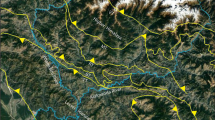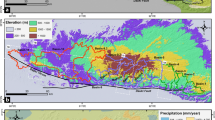Abstract
Accurate delineation and characterization of valley-bottom settings is crucial to the assessment of the biological and geomorphological components of riverine systems; yet, to date, most valley-bottom mapping endeavors have been done manually. To improve this situation, we developed automated techniques in a Geographic Information System (GIS) for delineating and characterizing valley-bottom settings in river basins ranging in size from approximately 1,000–10,000 km2. All procedures were developed with ARC/INFO GIS software and fully automated in Arc Macro Language (AML). The GRID module is required for valley-bottom delineation and slope calculations; whereas characterization (i.e., measuring the width of the valley-bottom zone) requires Coordinate Geometry (COGO) in the ARCEDIT module. The process requires three inputs: a polygon coverage of the analysis area; an arc coverage of its hydrography, and a grid representing its digital elevation. The AML is designed to operate within a wide range of computer memory/disk space options, and it allows users to customize several procedures to match the scale and complexity of a given analysis area with available computer hardware.
Similar content being viewed by others
References
Garbrecht, J. and Starks, P.:1995, ‘Note on the use of USGS Level 1, 7.5 minute DEM coverages for landscape drainage analyses’ Photogrammetric Engineering & Remote Sensing, 61, 519–522.
Jensen, M., Goodman, I., Brewer, K. [and others]:1997, ‘Biophysical environments of the basin’ in: An Assessment of Ecosystem Components in the Interior Columbia Basin and Portions of the Klamath and Great Basins: Volume 1, Gen. Tech. Rep. PNW-GTR-405, Quigley, T. M., Arbelbide, S.J. (tech. eds.), Portland, OR, U.S. Department of Agriculture, Forest Service, Pacific Northwest Research Station, 335pp.
Maxwell, J. R., Edwards, C. J., Jensen, M. E., Paustian, S. J., Parrott, H. and Donley, M.: 1995, A hierarchical framework of aquatic ecological units in North America (nearctic zone), Gen. Tech. Rep. NC-176, St. Paul, MN, U.S. Department of Agriculture, Forest Service, North Central Forest Experiment Station, 72pp.
Montgomery, D. R., Grant, G. E. and Sullivan, K.: 1995, ‘Watershed analysis as a framework for implementing ecosystem management’ Water Resources Bulletin, 31(3), 369–386.
USGS: 1990, Digital Elevation models data users guide, Reston, Virginia, 51pp.
Author information
Authors and Affiliations
Rights and permissions
About this article
Cite this article
Williams, W.A., Jensen, M.E., Winne, J.C. et al. An Automated Technique for Delineating and Characterizing Valley-Bottom Settings. Environ Monit Assess 64, 105–114 (2000). https://doi.org/10.1023/A:1006471427421
Issue Date:
DOI: https://doi.org/10.1023/A:1006471427421




